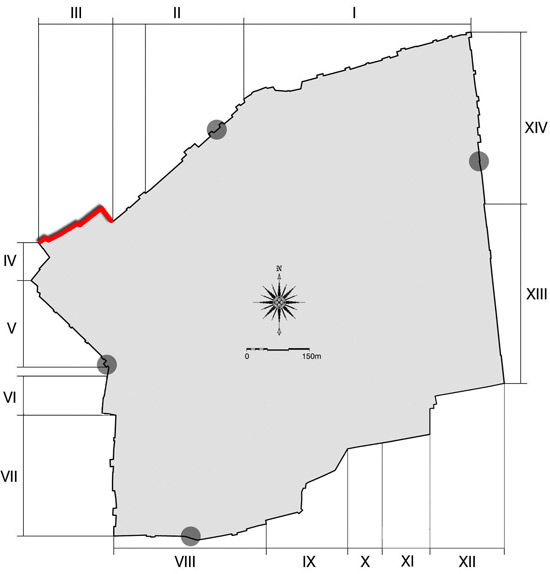|
|
| The Franciscan Section |

|
The Franciscan section of the city wall, that is the northwestern section of the Old City wall, exists along its present route from the time of the Roman period.
In the Herodian period the city was enlarged and residential quarters were built north of what is today the line of the Franciscan section of the city wall. Later Agrippa enclosed these neighborhoods in a wall that Josephus refers to in his writings as the Third Wall.
In the Roman period, from the time of the Temple's destruction in 70 CE until the third century, the city stood without defensive walls. The city remained unprotected following the departure of the Roman Tenth Legion from Jerusalem. The new wall was probably built at this time along the line of the present day northern wall of the Old City.
In the Byzantine period the city flourished and many buildings were constructed in it. Evidence of the wall's construction and rehabilitation in the fifth century CE is ascribed to the empress Eudocia who is known to have "expanded the limits of Jerusalem and strengthened its city walls". The route of the northern wall remained unchanged, and was also used in the Early Islamic period, as described by the tenth century historian-geographer al-Maqaddasi.
In the Crusader period the city was breached from the north. Several years after the conquest the Crusaders built a line of fortifications that subsequently constituted the basis of the Ottoman city wall. The northern route of the Crusader city wall ran approximately 8 meters north of the Ottoman wall. The fortifications built then included towers positioned at set intervals, a 14 meter wide moat and four fortresses, one in each corner of the wall. Tancred's Tower, known also by its Arabic name Burj Jalud (Goliath's Tower), was erected in the northwestern corner.
In 1178 Saladin's army entered Jerusalem by way of the northern wall and conquered the city. A number of years after the conquest Saladin began rehabilitating the city walls and its fortifications. The route of the northern city wall dating from the Crusader period continued to be used in this period.
In the Ottoman period, after the sultan Suleiman erected the walls in 1535 CE, the northern wall was constructed along the route of the Roman wall and on the basis of previous walls.
By the end of the nineteenth century, with the improved stability and overall security in the region, the European powers began to intervene more actively in the affairs in Jerusalem. Residential quarters were built and commerce developed outside the city walls. The construction on either side of the Franciscan wall, both outside the city wall and in the area of the Franciscan monastery, left a small passage between the buildings and the walls thereby necessitating a connecting gate. In 1889 the New Gate was opened in the wall in order to link the monasteries located on both sides of the wall.
In the British Mandate period many sections of the city wall were rehabilitated. The eastern part of the Franciscan section was also treated and missing or damaged crenellations were replaced or repaired.
In the Jordanian period the New Gate was closed because it was located along the border between Israel and Jordan.
Following the reunification of the city, after the Six Day War, the gate was opened to traffic. To this day the damage is still visible which was caused by the bullets that struck the gate.
|
|

|
| Orientation map |
|
 |
 |
|
|
| Websites, text and photos © Israel Antiquities Authority |
Powered by teti-tu |
|
|















